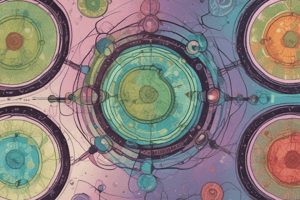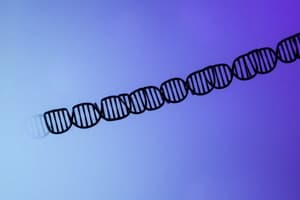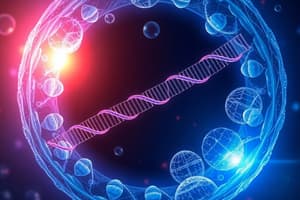Podcast
Questions and Answers
During which phase of mitosis does the nuclear envelope break down, allowing microtubules to contact kinetochores?
During which phase of mitosis does the nuclear envelope break down, allowing microtubules to contact kinetochores?
- Metaphase
- Prophase
- Prometaphase (correct)
- Telophase
What is the primary function of the Anaphase Promoting Complex (APC) during anaphase?
What is the primary function of the Anaphase Promoting Complex (APC) during anaphase?
- Condensing chromosomes in preparation for cell division
- Inactivating mitotic cyclin-dependent kinase (M-Cdk) (correct)
- Synthesizing new nuclear envelopes around daughter chromosomes
- Facilitating chromosome replication
At which stage of mitosis are sister chromatids split into two identical sets of chromosomes?
At which stage of mitosis are sister chromatids split into two identical sets of chromosomes?
- Anaphase (correct)
- Telophase
- Metaphase
- Prophase
Which cellular component is responsible for physically separating the daughter chromosomes during anaphase?
Which cellular component is responsible for physically separating the daughter chromosomes during anaphase?
What event directly follows telophase in the cell cycle?
What event directly follows telophase in the cell cycle?
If a cell has 20 picograms of DNA in G1 phase, how many picograms of DNA will it have after S phase, assuming complete replication?
If a cell has 20 picograms of DNA in G1 phase, how many picograms of DNA will it have after S phase, assuming complete replication?
Which of the following events occurs during telophase?
Which of the following events occurs during telophase?
What is the immediate consequence of cohesion destruction during mitosis?
What is the immediate consequence of cohesion destruction during mitosis?
Which event is LEAST likely to occur during prophase?
Which event is LEAST likely to occur during prophase?
What is the primary role of cohesin during prophase?
What is the primary role of cohesin during prophase?
What is the IMMEDIATE result of the abrupt increase in M-Cdk activity during prophase?
What is the IMMEDIATE result of the abrupt increase in M-Cdk activity during prophase?
How would the absence of M-Cdk affect prometaphase?
How would the absence of M-Cdk affect prometaphase?
What event characterizes the transition from prometaphase to metaphase?
What event characterizes the transition from prometaphase to metaphase?
During metaphase, what force ensures sister chromatids align at the metaphase plate?
During metaphase, what force ensures sister chromatids align at the metaphase plate?
If motor proteins on kinetochore microtubules malfunctioned during metaphase, what would be the MOST likely outcome?
If motor proteins on kinetochore microtubules malfunctioned during metaphase, what would be the MOST likely outcome?
Which statement accurately describes the relative duration of the phases?
Which statement accurately describes the relative duration of the phases?
Which of the following accurately describes the role of microtubules in cell division?
Which of the following accurately describes the role of microtubules in cell division?
How does cytokinesis differ between plant and animal/fungi cells?
How does cytokinesis differ between plant and animal/fungi cells?
What is the primary function of the actin-myosin contractile ring during cell division?
What is the primary function of the actin-myosin contractile ring during cell division?
If a cell is treated with an antimitotic agent during metaphase, what would be the most likely outcome?
If a cell is treated with an antimitotic agent during metaphase, what would be the most likely outcome?
Taxol is an antimitotic drug that affects microtubule function. What is the most likely reason it is used in cancer treatment?
Taxol is an antimitotic drug that affects microtubule function. What is the most likely reason it is used in cancer treatment?
Which of the following represents the correct sequence of events during cell division?
Which of the following represents the correct sequence of events during cell division?
How does the genetic material in the two daughter cells compare after cytokinesis, assuming normal cell division?
How does the genetic material in the two daughter cells compare after cytokinesis, assuming normal cell division?
What would be the immediate consequence if the Golgi apparatus were non-functional during cytokinesis in a plant cell?
What would be the immediate consequence if the Golgi apparatus were non-functional during cytokinesis in a plant cell?
Taxanes exert their anti-cancer effect by which of the following mechanisms?
Taxanes exert their anti-cancer effect by which of the following mechanisms?
Vinca alkaloids, such as vincristine and vinblastine, disrupt cell division by:
Vinca alkaloids, such as vincristine and vinblastine, disrupt cell division by:
Which of the following accurately describes the role of M-Cdk in the cell cycle?
Which of the following accurately describes the role of M-Cdk in the cell cycle?
How do antimitotic agents selectively target cancer cells compared to normal cells?
How do antimitotic agents selectively target cancer cells compared to normal cells?
During which phase of the cell cycle do taxanes primarily exert their effect?
During which phase of the cell cycle do taxanes primarily exert their effect?
If a researcher wants to study the effects of a drug that prevents chromosomal segregation, which phase of the cell cycle should they focus on?
If a researcher wants to study the effects of a drug that prevents chromosomal segregation, which phase of the cell cycle should they focus on?
A scientist observes that cells treated with a certain drug are unable to form the mitotic spindle. Which of the following drugs is most likely responsible for this effect?
A scientist observes that cells treated with a certain drug are unable to form the mitotic spindle. Which of the following drugs is most likely responsible for this effect?
Which of the following cellular processes is directly inhibited by both Vinca alkaloids and Colchicine?
Which of the following cellular processes is directly inhibited by both Vinca alkaloids and Colchicine?
Which of the following outcomes is LEAST directly ensured by the cell cycle checkpoints?
Which of the following outcomes is LEAST directly ensured by the cell cycle checkpoints?
During which phase of the cell cycle does DNA replication occur?
During which phase of the cell cycle does DNA replication occur?
A researcher observes a cell population with an increased rate of aneuploidy. Which cell cycle checkpoint is most likely malfunctioning in these cells?
A researcher observes a cell population with an increased rate of aneuploidy. Which cell cycle checkpoint is most likely malfunctioning in these cells?
What is the primary function of mitosis (M phase) in somatic cells?
What is the primary function of mitosis (M phase) in somatic cells?
In multicellular organisms, the purpose of cell division does NOT include:
In multicellular organisms, the purpose of cell division does NOT include:
If a toxin inhibits cytokinesis, but not mitosis, what outcome would you expect to observe in treated cells?
If a toxin inhibits cytokinesis, but not mitosis, what outcome would you expect to observe in treated cells?
Which of the following describes the state of a cell in the G0 phase?
Which of the following describes the state of a cell in the G0 phase?
A mutation causes a cell to bypass the G1 checkpoint. What is the most likely consequence of this mutation?
A mutation causes a cell to bypass the G1 checkpoint. What is the most likely consequence of this mutation?
What cellular process primarily occurs during the G1 phase of the cell cycle?
What cellular process primarily occurs during the G1 phase of the cell cycle?
Consider a drug that interferes with the function of the mitotic spindle. At which specific phase of the cell cycle would this drug most likely arrest cells?
Consider a drug that interferes with the function of the mitotic spindle. At which specific phase of the cell cycle would this drug most likely arrest cells?
If a mammalian cell spends approximately 10-12 hours in S phase, what percentage of the total cell cycle does this represent?
If a mammalian cell spends approximately 10-12 hours in S phase, what percentage of the total cell cycle does this represent?
Sister chromatids are joined together at what specialized region of the chromosome?
Sister chromatids are joined together at what specialized region of the chromosome?
During which phase of the cell cycle does DNA replication occur?
During which phase of the cell cycle does DNA replication occur?
What is primarily monitored during the gap phases (G1 and G2) of interphase?
What is primarily monitored during the gap phases (G1 and G2) of interphase?
Which of the following best describes the primary function of the G2 checkpoint?
Which of the following best describes the primary function of the G2 checkpoint?
What is the significance of the checkpoint in the G1 phase?
What is the significance of the checkpoint in the G1 phase?
If a cell with damaged DNA proceeds through the G1 checkpoint, which of the following outcomes is most likely?
If a cell with damaged DNA proceeds through the G1 checkpoint, which of the following outcomes is most likely?
How does the duration of the M phase compare to the other phases of the cell cycle in mammalian cells?
How does the duration of the M phase compare to the other phases of the cell cycle in mammalian cells?
Flashcards
Interphase
Interphase
A nondividing phase of the cell cycle including G1, S, and G2 phases.
G1 phase
G1 phase
The first gap phase where the cell grows and synthesizes proteins and organelles.
S phase
S phase
The synthesis phase where DNA replication occurs and chromosomes are duplicated.
G2 phase
G2 phase
Signup and view all the flashcards
G0 phase
G0 phase
Signup and view all the flashcards
Sister chromatids
Sister chromatids
Signup and view all the flashcards
Centromere
Centromere
Signup and view all the flashcards
Mitosis (M) phase
Mitosis (M) phase
Signup and view all the flashcards
Cytokinesis
Cytokinesis
Signup and view all the flashcards
Chromosome distribution
Chromosome distribution
Signup and view all the flashcards
Cell Cycle
Cell Cycle
Signup and view all the flashcards
G1 Checkpoint
G1 Checkpoint
Signup and view all the flashcards
G2 Checkpoint
G2 Checkpoint
Signup and view all the flashcards
Mitosis
Mitosis
Signup and view all the flashcards
Checkpoints
Checkpoints
Signup and view all the flashcards
Aneuploidy
Aneuploidy
Signup and view all the flashcards
Subphases of M phase
Subphases of M phase
Signup and view all the flashcards
Prophase
Prophase
Signup and view all the flashcards
Prometaphase
Prometaphase
Signup and view all the flashcards
Metaphase
Metaphase
Signup and view all the flashcards
M-Cdk
M-Cdk
Signup and view all the flashcards
Anaphase
Anaphase
Signup and view all the flashcards
Telophase
Telophase
Signup and view all the flashcards
Anaphase Promoting Complex (APC)
Anaphase Promoting Complex (APC)
Signup and view all the flashcards
Mitotic Arrest
Mitotic Arrest
Signup and view all the flashcards
Paclitaxel
Paclitaxel
Signup and view all the flashcards
Vinca alkaloids
Vinca alkaloids
Signup and view all the flashcards
Colchicine
Colchicine
Signup and view all the flashcards
Cell Cycle Phases
Cell Cycle Phases
Signup and view all the flashcards
Antimitotic Agents
Antimitotic Agents
Signup and view all the flashcards
Actin-myosin ring
Actin-myosin ring
Signup and view all the flashcards
Cytokinesis in plants
Cytokinesis in plants
Signup and view all the flashcards
Cytokinesis in animals
Cytokinesis in animals
Signup and view all the flashcards
Microtubules
Microtubules
Signup and view all the flashcards
Study Notes
Cell Cycle Overview
- The cell cycle is a series of intracellular events leading to the production of two identical daughter cells
- The genetic code is passed along
- All living organisms are products of repeated cell division rounds
- Unicellular organisms reproduce through binary fission
- Multicellular organisms divide for growth, repair, and replacement
Cell Cycle Checkpoints
- The cell cycle is regulated by checkpoints
- G1 checkpoint: before entering S phase
- G2 checkpoint: before entering M phase
- Metaphase checkpoint: during cell division
- Checkpoints control orderly progression, high-fidelity DNA replication, DNA damage repair, and correct chromosome segregation
- Problems like aneuploidy (extra or missing chromosomes) and mutations can disrupt the cell cycle
Interphase: G Phases
- Interphase includes G1, S, and G2 phases
- G1 phase: initial growth and metabolic phase
- S phase: DNA replication
- G2 phase: growth and synthesis of structural elements
- G0 is a resting phase where some cells (e.g., mature muscle cells, neurons) remain outside the active cell cycle
Interphase: G Phases - Detailed
- G phases are important for organelle replication and cytoplasmic expansion in preparation for division.
- During these phases, cells also monitor internal and environmental conditions
- Cells that don't proceed through the checkpoints can either delay or arrest their cycle by entering the G0 phase.
- Unfavorable environments can also initiate cell cycle arrest
Interphase: S Phase
- S phase is the cell synthesis phase where DNA replication takes place.
- DNA copies are called sister chromatids and are joined together in a specialized region named the centromere.
- Packaging proteins are also replicated during this stage
Mitosis (M) Phase
- Mitosis is a stage of nucleus division, often accompanied by cytokinesis (cytoplasm division).
- Aims to distribute chromosomes to daughter cells.
- Replicated chromosomes are equally divided.
- Two daughter nuclei with identical chromosomes and genes are formed
Mitosis (M) Phase - Subphases
- Mitosis is a continuous process with five subphases (PPMAT)
- Prophase: Chromosomes condense, centrosomes move to opposite poles
- Prometaphase: Nuclear envelope breaks down, microtubules attach to chromosomes
- Metaphase: Chromosomes align at the metaphase plate in the center of the cell.
- Anaphase: Sister chromatids separate and move to opposite poles
- Telophase: Chromosomes decondense, nuclear envelopes re-form
Mitosis (M) phase - Cytokinesis
- Cytoplasm division completes cell division
- Each daughter cell receives a complete set of organelles and genetic material.
- In animal cells, a contractile ring of actin-myosin filaments pinches the cell membrane inward (cleavage furrow) to create two separate cells
- In plants, vesicles from the Golgi apparatus fuse to form a cell plate creating a new cell wall.
Antimitotic Agents
- Drugs that interfere with mitosis
- Affect microtubule assembly and disassembly.
- Examples: Taxols (e.g., Paclitaxel, Docetaxel), Vinca alkaloids (e.g., Vincristine, Vinblastine), Colchicine, and Nocodazole.
- Used for cancer treatment targeting rapidly dividing cells
- MOA involves disrupting microtubule function and arresting cells in metaphase
Summary of Cell Cycle & Mitosis
- Cell cycle consists of interphase (G1, S, G2) and the mitotic (M) phase.
- The M-phase involves replicated chromosome segregation, and formation of two daughter nuclei
- Prophase, prometaphase, metaphase, anaphase, telophase, and cytokinesis are the phases of M-phase
- Anti-mitotic agents target microtubules to inhibit cell division for cancer treatment
Studying That Suits You
Use AI to generate personalized quizzes and flashcards to suit your learning preferences.




